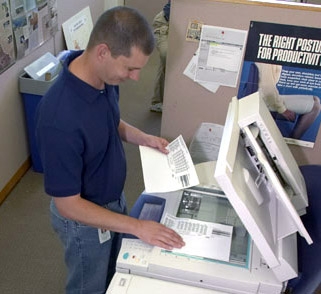Practices that Use Less Paper

Cutting back on unnecessary paper use can be an unobtrusive, gradual process that will yield savings instantly. For best results, start out with a few easy changes and step up your efforts over time.
Most best practices to reduce office paper fall into three main categories:
- Electronic instead of paper documents
- Duplex printing and copying instead of single sided
- Reuse of single sided print-outs, envelopes and other paper products.
Electronic instead of paper documents
- Distribute reports and memos electronically
- Scan incoming paperwork and store all documents on a network rather than in filing cabinets.
- Switch to electronic forms such as timesheets, purchase orders, and incident reports.
- Print on-demand rather than stockpiling paper documents like letterhead and newsletters that will become outdated.
- E-mail documents rather than faxing them, or fax them electronically from your computer instead of using hard copies. Search the Internet to find an electronic fax service that meets the needs of your organization.
- Avoid printing e-mails and web pages; file them on a hard drive not in a filing cabinet.
FAQs
Question: How is my organization going to pay for the costs of transitioning to electronic instead of paper documents?
Answer: In most cases, businesses realize a quick payback on the necessary investments through reduced costs and improved efficiency.
Question: Won’t converting all that paperwork take too much time?
Answer:In the long run electronic files will save staff time by making it quicker and easier to find information. To help with the initial transition, use high-speed scanners and consider hiring temporary help.
Question: My organization deals with financial transactions, legal agreements, and contracts. If we switch to electronic documents, how will we verify document authenticity and prevent tampering?
Answer: Use software with digital signature and document security features. Encrypted digital signatures are actually harder to forge than handwritten ones!
Duplex printing and copying instead of single sided
- Print on both sides of a sheet instead of just the front.
- Set the default on all copiers and printers to duplex.
FAQs
Question: How am I going to get my co-workers to participate and learn how to use the equipment’s duplexing features?
Answer: Try to get your office to adopt a formal policy to duplex all documents and work with IT staff to set printing equipment to default duplex. Make a point of training staff to properly use equipment, and post how-to signage at copier locations.
Question: The equipment in my office doesn’t have duplexing capabilities. What can I do?
Answer: If you are leasing your equipment, request duplex capable equipment. If you own the equipment, consider making this feature a requirement for future purchases.
Reusing single sided print-outs, envelopes and other paper products
- Use paper that has printing on only one side and is blank on the other in a designated “draft” copier, printer, or paper tray.
- Reuse manila envelopes for internal mailings.
- Use outdated letterhead for in-house memos.
FAQs
Question: Won’t collecting scrap paper be too much work, and won’t it just jam up the machines?
Answer: Provide trays and create signage to collect used single sided paper and place near all equipment. Provide information about how to prevent jams, such as not using folded, formerly stapled or damp paper.
Question: How can I be sure that staff won’t accidently put confidential materials in the scrap paper tray?
Answer: Train staff to properly dispose of confidential materials. In addition, put signs on scrap paper collection trays that clearly state: No Confidential Material
Question: Won’t documents printed on scrap paper look unprofessional, and the content on the back pre-printed side confuse people?
Answer: Re-use single-sided paper only for draft documents. To avoid confusion use a rubber stamp to print “Reused Paper” in a large font size on the pre-printed side.
Thanks to the University of Toronto’s Sustainability Office for their contribution to some of the FAQs in this section.
Related content on this website:
The Impact of Paper Waste: Get the facts on the toll paper waste takes on the environment and the bottom line.
Paperless Express: This comprehensive and easy to follow guide provides tips and tools for office workers and managers in business, government, and other organizations. You will find steps to reduce paper at your desk, in the mail room, by using new technologies, and in many other ways.